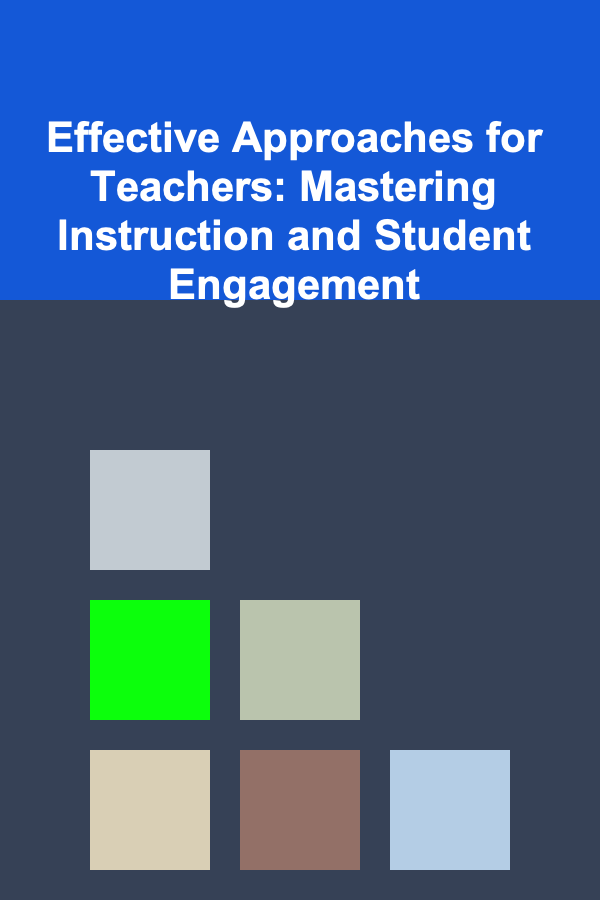
Effective Approaches for Teachers: Mastering Instruction and Student Engagement
ebook include PDF & Audio bundle (Micro Guide)
$12.99$8.99
Limited Time Offer! Order within the next:

Teaching is an evolving and dynamic profession. Effective teachers do more than deliver content; they inspire, engage, and foster a positive learning environment that encourages students to develop critical thinking, curiosity, and a lifelong love for learning. However, this requires more than just knowledge of the subject matter. It involves mastering instructional strategies, understanding diverse student needs, and consistently adapting to new challenges in the classroom.
This guide offers actionable strategies for teachers who are striving to enhance their instructional techniques and maximize student engagement. These methods focus on creating a responsive, student-centered classroom environment while fostering meaningful learning experiences.
Understanding Student-Centered Learning
Student-centered learning is a teaching approach that prioritizes the needs, interests, and abilities of students over traditional, teacher-centered methods. In this model, students take an active role in their learning, and teachers serve as facilitators who guide, support, and challenge them.
Personalizing Instruction
To engage students effectively, it's essential to tailor instruction to meet their individual needs. This can be achieved through differentiated instruction, where content, process, and products are adapted to cater to the diverse abilities and learning styles of students. By understanding each student's learning profile, teachers can design lessons that offer varying levels of complexity, different types of materials, and various modes of delivery.
- Use formative assessments: Regular checks for understanding, such as quizzes, one-on-one interactions, or quick written responses, allow teachers to identify areas where students are struggling and adjust instruction accordingly.
- Group students strategically: Vary groupings throughout the course to provide opportunities for students to collaborate with peers who bring different perspectives and skills. This promotes both social interaction and deeper learning.
Incorporating Student Interests
Linking lessons to students' personal interests and experiences can create a sense of relevance, which enhances engagement. When students feel that the content matters to them personally, they are more likely to invest time and energy in the subject.
- Integrate real-world applications: Whenever possible, connect classroom topics to real-world situations. This helps students see how the material can be applied beyond the classroom and into their own lives.
- Provide student choice: Allowing students to choose topics for projects or select between different learning activities can increase their investment in the learning process. Autonomy fosters motivation and engagement.
Mastering Active Learning Techniques
Active learning is an instructional approach that encourages students to participate in their learning actively, rather than passively receiving information. When students engage with the material, collaborate with others, and apply their knowledge, they are more likely to retain information and develop critical thinking skills.
Incorporate Problem-Based Learning (PBL)
PBL encourages students to work on real-world problems in groups, requiring them to apply their knowledge and think critically. This hands-on learning experience is more engaging than traditional lecture-based instruction.
- Design meaningful problems: Choose problems that are authentic and challenging. Problems should be relevant to students' interests and applicable to the real world.
- Foster collaboration: Encourage students to work in teams, allowing them to exchange ideas, learn from one another, and develop important communication skills.
Interactive Discussions and Socratic Seminars
A powerful way to engage students is through thoughtful discussion and questioning. Socratic seminars promote deeper understanding by challenging students to critically examine ideas and defend their positions with evidence.
- Use open-ended questions: Encourage students to think critically by asking questions that don't have a simple yes or no answer. These types of questions stimulate deeper reflection and discussion.
- Promote respectful debate: Teach students to listen actively, respectfully disagree, and build on the ideas of others. This cultivates a classroom environment where diverse viewpoints are respected and explored.
Incorporating Technology in the Classroom
Technology can significantly enhance instruction and student engagement when used effectively. By integrating digital tools into teaching, teachers can create more dynamic, interactive, and personalized learning experiences.
Leverage Educational Software and Tools
There is a vast array of tools available to enhance classroom learning. For example, tools like Kahoot!, Google Classroom, or Padlet allow for interactive assessments, collaborative activities, and easy sharing of resources. These platforms also make it possible to provide instant feedback, which is crucial for maintaining engagement.
- Gamify learning: Using gamification in the classroom---where students can earn points, badges, or rewards for completing tasks or reaching milestones---can make learning more enjoyable and motivating.
- Incorporate multimedia: Videos, podcasts, and interactive simulations can bring abstract concepts to life, making the material more engaging and memorable.
Use Flipped Classroom Models
A flipped classroom allows students to explore content at their own pace outside of class, freeing up in-class time for collaborative projects, discussions, or hands-on activities. This approach gives students more control over their learning while allowing teachers to focus on active engagement and deeper learning during face-to-face time.
- Provide structured materials: Offer online resources like recorded lectures, reading materials, or guided practice activities that students can complete before class. This ensures that in-class time can be devoted to more meaningful interactions.
- Foster peer-to-peer learning: In-class activities should promote collaboration. Allow students to work together to solve problems or discuss the material they've studied independently.
Building a Positive and Inclusive Classroom Culture
Creating a positive and inclusive classroom environment is fundamental to fostering student engagement. A classroom where students feel safe, respected, and valued is one where they will be more likely to actively participate and take risks in their learning.
Set Clear Expectations and Routines
Establishing clear expectations for behavior, communication, and work helps students understand what is expected of them. Routines create a predictable structure, which makes students feel comfortable and confident in their environment.
- Be consistent: Consistency is key to building trust. Apply rules and routines fairly and consistently, ensuring that students know what is expected of them at all times.
- Encourage respect: Set the tone for respectful behavior from day one. Model and reinforce respectful interactions, whether in discussions, group work, or independent activities.
Promote Social-Emotional Learning (SEL)
Social-emotional learning is an essential part of a positive classroom environment. When students develop emotional intelligence, they are better equipped to manage stress, navigate relationships, and engage with others in constructive ways.
- Incorporate SEL activities: Use activities like mindfulness exercises, team-building games, or reflective journaling to help students develop emotional awareness and interpersonal skills.
- Create a safe space for students: Foster an environment where students feel comfortable sharing their thoughts, feelings, and challenges. Encouraging empathy and active listening among students helps to cultivate a caring and supportive atmosphere.
Implementing Ongoing Assessment and Feedback
Assessment and feedback are critical to understanding student progress and adjusting instruction accordingly. However, assessments should not solely be used as a means of grading; they should also guide and improve learning.
Use Formative Assessments
Formative assessments are ongoing assessments that provide feedback during the learning process rather than at the end. These assessments allow teachers to make real-time adjustments to instruction based on students' needs.
- Exit tickets: Use exit tickets at the end of lessons to gauge students' understanding. These short prompts can reveal areas where students are struggling and allow you to provide immediate support.
- Peer and self-assessment: Allowing students to assess their own work or the work of their peers encourages reflection and ownership of their learning. It also provides teachers with valuable insights into student progress.
Provide Constructive Feedback
Feedback should be timely, specific, and constructive. Rather than simply marking work as "right" or "wrong," feedback should encourage students to reflect on their strengths and areas for improvement.
- Be specific: Instead of saying, "Good job," provide specific feedback like, "I was impressed with how you supported your argument with evidence from the text. Next time, try to include even more examples to strengthen your argument further."
- Focus on growth: Frame feedback in a way that encourages improvement. Use language that motivates students to view mistakes as opportunities for learning rather than setbacks.
Conclusion
Mastering instruction and student engagement is a multifaceted process that requires thoughtful planning, flexibility, and a deep understanding of students' needs. By adopting student-centered practices, incorporating active learning, leveraging technology, building an inclusive classroom culture, and providing timely feedback, teachers can create an environment that fosters both academic achievement and personal growth. The goal is not only to impart knowledge but to inspire students to become lifelong learners, critical thinkers, and engaged citizens. Effective teaching is a continuous journey, one that demands creativity, reflection, and a commitment to student success.
Reading More From Our Other Websites
- [Needle Felting Tip 101] How to Incorporate Botanical Elements into Needle‑Felted Arrangements for Botanical Illustration Projects
- [Trail Running Tip 101] Best Trail‑Running Techniques for Efficient Running on Uneven Surfaces
- [Organization Tip 101] Common Signs That Indicate It's Time to Replace Your Chimney Cap
- [Gardening 101] Step‑by‑Step Guide: Building a Sturdy Wooden Trellis for Flowers & Vines
- [Sewing Tip 101] Sewing Savings Checklist: Must-Have Supplies That Won't Break the Bank
- [Hiking with Kids Tip 101] Kid‑Friendly Hiking Gear: Mastering the Three‑Layer System for Outdoor Adventures
- [Gardening 101] The Best Plants and Decorations for Your Fairy Garden
- [Organization Tip 101] DIY Plumbing: Simple Repairs You Can Do Yourself
- [Organization Tip 101] How to Establish a Routine for Regular Decluttering
- [Personal Financial Planning 101] How to Build an Emergency Fund to Prepare for Financial Uncertainty

How to Invest in Startups with Crowdfunding Platforms
Read More
How to Plan a Budget-Friendly Party at Home Without Sacrificing Style
Read More
How to Reduce Your Monthly Rent or Mortgage Payment Without Moving
Read More
How to Protect Your Data on Social Media
Read More
How to Practice the Art of Letting Go
Read More
How to Design a Functional and Beautiful Home Office
Read MoreOther Products

How to Invest in Startups with Crowdfunding Platforms
Read More
How to Plan a Budget-Friendly Party at Home Without Sacrificing Style
Read More
How to Reduce Your Monthly Rent or Mortgage Payment Without Moving
Read More
How to Protect Your Data on Social Media
Read More
How to Practice the Art of Letting Go
Read More